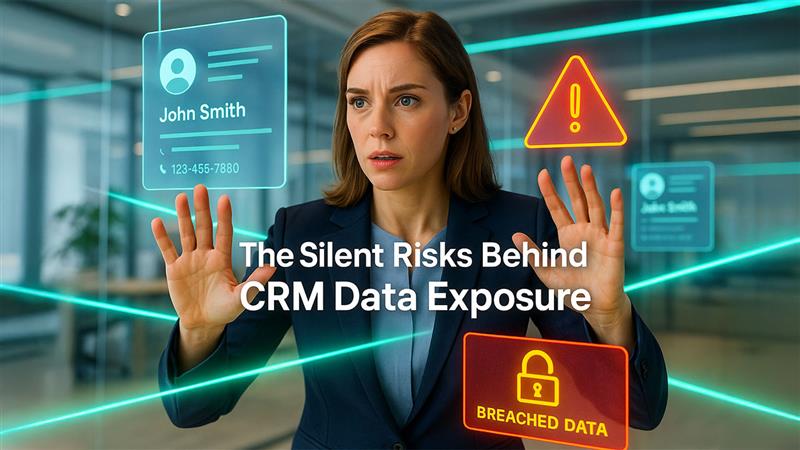CRM systems have become not only a tool for managing contacts and sales. Now they are also a repository for large amounts of sensitive customer data, interaction histories, and business processes. As a result, data breaches in CRM systems are one of the most serious risks. Financial stability, client trust, and the company's reputation are all on the line. To effectively prevent current risks, businesses must have a better grasp of how CRM assaults work and which vulnerabilities are most frequently used as entry points by attackers. Only with a complete approach to security can businesses reduce risks and preserve control over essential information.
How Leaks Affect CRM
When a consumer discovers that their personal information has fallen into the hands of other parties, rebuilding trust is exceedingly difficult and costly.
So, the first strike is a breach of trust.
Additionally, there are:
- Regulatory risks (fines for violating GDPR, CCPA, etc.);
- Incident response costs;
- Legal claims;
- Indirect losses — decreased sales and customer churn.
Intervention nature. Ways of spreading
Data Breach in CRM incidents can be the result of external hacking or internal incidents. External hacking includes phishing, exploits, and API attacks. Internal hacking involves employee carelessness and unauthorized access.
Three categories of losses are particularly painful in CRM:
- Personal data (names, contacts, addresses);
- Financial data (if stored);
- Confidential notes about customers or contract terms.
In many cases, the leak does not start within the CRM itself, but from the compromise of an employee's workstation. Namely, undetected malware, accumulated technical junk, or outdated software can easily become loopholes for attacks. That is why businesses increasingly turn their attention to tools that help keep devices stable and, therefore, secure. Among such tools, CleanMyMac Mac cleaner stands out, helping to clean the system, remove vulnerable program remnants, and update software in a timely manner. This significantly reduces the risk of a local computer becoming a starting point for accessing corporate data, including CRM.
Areas of Major Vulnerabilities

To know what to protect, you must understand specific CRM vulnerability points.
Access Settings. Privileges
If corporate roles are not segmented, employees have access to data they do not need for their work. Accordingly, the likelihood of accidental customer data exposure increases.
How to secure
Implement the following for access to CRM:
- Least privilege principle.
- Regular role reviews.
- Multi-factor authentication.
Social engineering. Phishing
Attacks on people remain the most successful. All it takes is hacking a sales manager's email, and the attacker gains access to a whole set of customer data in the CRM. Data breaches in CRM often begins with such social engineering attacks.
How to secure
- Regular training on phishing and attack simulations.
- Policies for sharing confidential information.
Integrations. API
Almost every CRM is connected to other systems. API keys, webhooks, or unprotected integrations can become entry points for attacks. Incorrect configuration and unprotected endpoints are a direct path to a leak.
How to secure
- Control integration permissions.
- Restrict IP access.
- Limit speed (rate limiting).
- Regularly audit integrations.
What Businesses Need to Do Immediately

Rethinking your approach to CRM security is key. Below is a priority action plan.
Audit. Data mapping
Start with a complete inventory of data in CRM:
- Which fields contain PII (Personally Identifiable Information)?
- Where are copies stored?
- Who has access?
With these answers, you can identify the most critical CRM vulnerability points and prioritize protection.
Encryption. Key management
Even if an attacker gains access to the database, encrypting data at rest and in transit lowers the danger of consumer data disclosure.
Manage keys and certificates properly.
Staff training. Security policies
Regular training lowers the danger of phishing attempts and human mistake. Implement clear data sharing policies and processes in the event of device loss or account compromise. This proactive approach helps prevent data breaches in CRM scenarios before they occur.
Monitoring. Response
Configure logging and SIEM systems to promptly discover access irregularities. Your incident response strategy should include communication with consumers, regulators, and the media.
Minimize CRM Breach Consequences. Long-Term Strategies
CRM protection should not be a one-time activity, but rather a continual process.
Security Architecture. Zero Trust.
The zero-trust strategy reduces faith in any user or service by default. Constant access permissions verification and micro-segmentation further decrease the attack surface.
Testing.
Do regular penetration tests, audit trails, and red team exercises. They will help identify vulnerabilities before attackers discover them.
Develop third-party policies.
Third parties are often a weak link in the security supply chain. Define requirements for CRM vendors and integrators:
- Encryption standards;
- Security audits;
- Incident response SLAs.
Conclusion
CRM data breaches are a complex threat that affects the legal sphere, finances, and reputation. Protecting data breaches in CRM requires a multi-layered approach. If you want to minimize CRM breach consequences and limit customer data exposure, you must:
- Understand CRM vulnerability points;
- Implement a consistent CRM security policy;
- Perform regular data audits;
- Be prepared for incidents.
Invest in security and a culture of careful data handling today and you will save much more tomorrow. Namely, you will retain customer trust and avoid the costly consequences of breaches.



